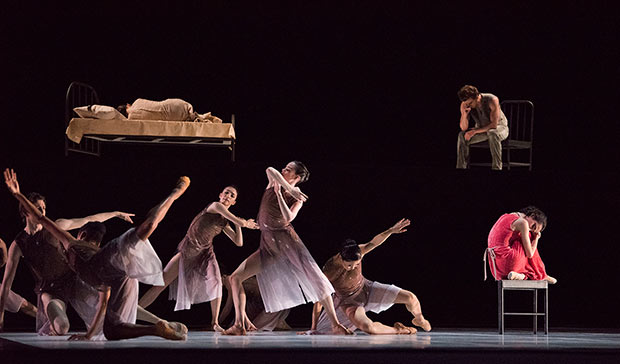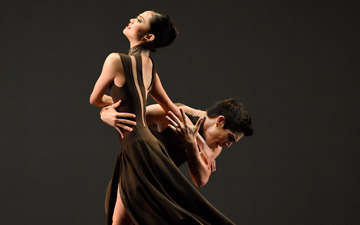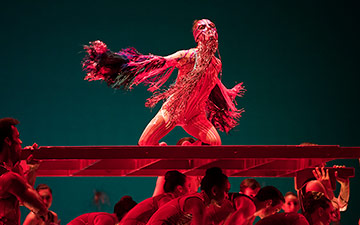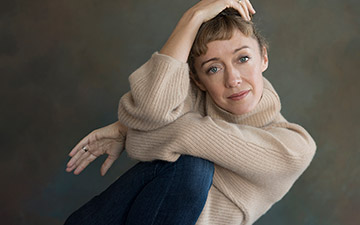
© Erik Tomasson. (Click image for larger version)
San Francisco Ballet
Unbound Festival Program B: Otherness, Snowblind, Anima Animus
★★★✰✰
San Francisco, War Memorial Opera House
21 April 2018
www.sfballet.org
For the second night in a row, the Bay Area dance community (and I’m sure a good number of folks from elsewhere) flocked to the War Memorial Opera House and San Francisco Ballet’s Unbound Festival – two and a half weeks of premieres by twelve different choreographers. I must admit I was pulled to the line-up for Programs B and C, the first of which opened Saturday night. I’m a fan of all three choreographers on both bills, no question. But I was particularly excited that these two add female voices to the mix, something that is uncommon at SF Ballet.
Full disclosure – during the bows for Otherness, choreographed by SFB corps dancer Myles Thatcher, people around me erupted in wild applause. The audience really responded to the work. And usually, I too, am pulled to Thatcher’s choreography. But Otherness wasn’t for me. Not because of the movement, nor the design, nor the staging, nor the concept – I actually thought that the piece was quite innovative in those respects. It was the narrative. Otherness seemed strongly focused in one direction – the search for distinction and individual identity. However, as the work ended, somehow that narrative had been replaced by a curious celebration of sameness.
Otherness introduces two gender-neutral cohorts (one pink, one blue), costumed by Sylvie Rood in mid-century bathing outfits, complete with swim caps. Choosing to make the gender-neutral groupings pink and blue was meaningful, as these two colors are long ingrained with gender bias. Each cast member also wore a pair of sunglasses, which I believe were fashioned by Warby Parker, the ever-trendy eyewear company. The sunglasses weren’t just for fun, they had metaphorical significance. As members of the cast removed them at various points in the dance, it felt like they were taking off masks, emerging out of expectation, and discovering something new about themselves. Marching motifs and sharp, angular movements gave the two communities an authoritative, strict demeanor, one which Max Cauthorn and Sean Orza (one from each cluster) would question and challenge throughout.

© Erik Tomasson. (Click image for larger version)
Switching costumes, Cauthorn and Orza took a turn walking in each other’s shoes. An array of emotions were present – moments of fear, desperation, anger and even some excitement at the unknown. As they navigated unfamiliar terrain, they met with some acceptance, some rejection, and even some abuse. Scoring the action was John Adams’ Absolute Jest. Absolute Jest is a phenomenal work, but here, a bit of a mis-match. While the music definitely changes at the end, Otherness’ ride of highs and lows called for something with much more dynamic range.
Eventually the entire cast shed their pink and blue skins, revealing common neon yellow costuming underneath. They experience the space together, dancing in unison. I get it, and it’s an important message, to be sure. Underneath it all, our commonalities far outweigh our differences. But all along, Otherness had been about two characters distinguishing their own reality and seeking their own path. The narrative fibers had split off in another direction, and it didn’t add up for me.
I knew that Cathy Marston’s Snowblind was inspired by Edith Wharton’s 1911 novel Ethan Frome, and so, I spent some time this week delving into the book. It’s about a harsh, desolate bond, set within a harsh, desolate environment. It’s a triangle between three characters: Ethan, his ill wife Zeena and Mattie, her cousin who has come to live with them and take care of Zeena. It’s about an existence marked and defined by duty, contrasted with the possibility that something different might be out there. And it’s about a tragic accident that changes the trajectory for all three, freezing them in an inescapable situation. Marston expertly captures Wharton’s tale, transforming its storyline into a captivating and haunting thirty-plus minute one-act ballet.
The harsh environment is crafted in a couple of ways. Snow factors heavy in Ethan Frome, which Marston mirrors in Snowblind, and not just with the dance’s title. The corps billow on and off the stage at several points in the work, their swirling arms and circling legs symbolizing wintery gusts and eddies. The scrim also features a snowy scene. Throughout the ballet, that scrim is often frozen at its halfway point; a perfect trope for a story whose characters feel frozen by their circumstances.

© Erik Tomasson. (Click image for larger version)
Snowblind’s characters, and the relationships between them, are revealed through Marston’s evocative choreography. Zeena and Ethan’s first duet is plagued with heavy obligation, the married pair danced by Sarah Van Patten and Ulrik Birkkjaer. As he carries her from one place to another, she clings to his back and he stoops over; both parties feeling the weight and gravity of their connection. In contrast, when we meet Mathilde Froustey’s Mattie, the scene is all joy and lightness; Froustey skipping and leaping about the space with boundless energy. That gleeful, free spirit oozed into Mattie and Ethan’s first dance, she making snow angels, he standing tall without a hint of constraint or responsibility. As their relationship grows and changes from friendship to longing, so does their physicality evolve – yearning caresses and clutched palms imbuing their pas de deux.
Snowblind also delved into the Zeena/Mattie storyline. We see Zeena’s disdain for Mattie in sharp angles, drawn fists, and cold, steely glances. Various trios of intertwined limbs show the intertwined nature of the three lives. And there was also solo work for each character. One standout was when Ethan expressed the struggle he felt between his commitment to Zeena and his freedom with Mattie. In a series of violent directional shifts, Birkkjaer reached repeatedly to one corner and then to another, back and forth, unsure of which route to take.
Then there is the tragedy, an accident in which Mattie is permanently injured. Now she is the one who needs a caregiver. In their final pas de trois, Van Patten, Birkkjaer and Froustey sink down toward the floor, grasping hands for balance and support. The triangle has changed, but the link between the three remains. Snowblind is a great narrative ballet – the source material is striking and Marston’s interpretation of it, equally so.

© Erik Tomasson. (Click image for larger version)
After two works that were heavy on the narrative, David Dawson’s Anima Animus brought something entirely different to the stage – a container in which glorious, non-stop movement could converse with Ezio Bosso’s pulsing, energetic score. An abstract work for ten including two principal women (Maria Kochetkova and Sofiane Sylve at this performance), Anima Animus was a sensory feast for the eye and ear. Dancers flew through the space in athletic ballet phrases. You didn’t want to look away for fear you would miss a moment of the dramatic, forward propulsion. James F. Ingalls’ lighting design was inspired. Rather than being lit from the front, Anima Animus was framed by a bright white light at the back of the stage. This meant that the dancers’ faces were slightly shadowed, which not only added a sense of anonymity, but ensured that the attention remained with the movement itself.
Anima Animus is the second work I’ve seen recently that, while abstract, also seemed to have some meaning or symbolism. I saw bird imagery throughout the dance – bodies gliding through the space, hands splayed like talons, flying/diving motifs in the lifts and high V arms, like the formation of a flock. More specifically, I wondered if Anima Animus was making a nod to Swan Lake. Yumiko Takeshima’s costumes were a mixture of black and white, and when coupled with the bird influences, I couldn’t get the Swan Lake connection out of my head (though Dawson’s choreography was completely and wonderfully different from the classic ballet). Save a few sticky moments in the partnering and the fact that the piece was a little long, Anima Animus brought Unbound’s Program B to a close with gusto and grandeur.

















thoroughly wonderful, detailed review. Such intelligence.